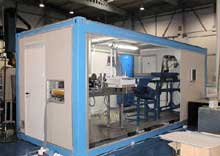`Artificial vision` for recycling copper

It’s in this machine where they recover copper from old cables
The technological centre Robotiker from Zamudio (Basque Country) has developed a system of artificial sight to separate metals that come with copper, in order to obtain high purity copper.
To recover copper from old cables it is not something new. However, the recycled copper is not pure, because it is mixed with other metals, such as lead, aluminium and tin. It is quite complicated to separate copper from those components by using mechanical, physical and other methods. Nevertheless it is easy to distinguish impurities through the eyesight.
The recycling of cables has been promoted by the need to change conventional telephone lines. The price of the material obtained from the recycling of electrical and telephone cables depends on the level of purity of the copper. Therefore, the fact of having lead, aluminium and tin along with copper determines the use and, hence, the price of copper.
With the system developed by Robotiker, after several processes the copper cable is divided into small pieces, and that divided copper has a purity of 99 %. The size of those pieces is variable, but usually it has 8-15 mm long, 3-1 mm wide and 1 mm high. When those pieces of the cable go along a belt, a camera with artificial sight can see them and differ them by the colour. If it realises it is not copper, it will reject it.
When copper has a purity of 99 %, it is used for plumbing and heating-systems. However, if it is going to be recycled for electrical use, its purity must be at least of 99.9 %. Thanks to the high purity obtained at the end of this new process, copper can be used for electrolytic processes, that is, for batteries. That was the aim of the companies that have developed the project together with Robotiker; more precisely the aim of Laining Industrial and two companies from the recycling sector Indumental Recycling and Botrade.
Thanks to this leading technique of artificial sight, materials can be separated by colour and shape. The result of this project (reduction of impurities from 10 to 1 with 1,000 Kg/hour flows) allows to expand in future such systems to other recycling processes.
Media Contact
More Information:
http://www.basqueresearch.com/index.asp?Gelaxka=1&hizk=IAll latest news from the category: Process Engineering
This special field revolves around processes for modifying material properties (milling, cooling), composition (filtration, distillation) and type (oxidation, hydration).
Valuable information is available on a broad range of technologies including material separation, laser processes, measuring techniques and robot engineering in addition to testing methods and coating and materials analysis processes.
Newest articles

Durable, Efficient, Sustainable: The Rise of Cerium Oxide Thermal Switches
Groundbreaking cerium oxide-based thermal switches achieve remarkable performance, transforming heat flow control with sustainable and efficient technology. Cerium Oxide-Based Thermal Switches Revolutionize Heat Flow Control Thermal switches, which electrically control…

How Industrial Robots are Reducing Emissions in Global Manufacturing
A new study explores the intersection of industrial automation and environmental sustainability, focusing on the role of industrial robots in reducing the carbon intensity of manufacturing exports. The research demonstrates…

Patients Can Heal Through Precise, Personalized Bioceramic Grafts
A recent review is transforming the landscape of craniomaxillofacial bone regeneration with the introduction of personalized bioceramic grafts. This pioneering research explores the fabrication and clinical potential of synthetic grafts…



